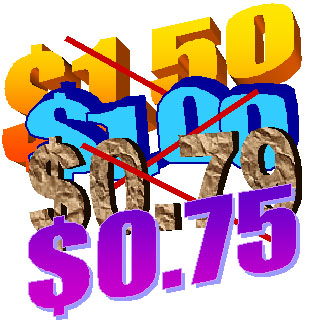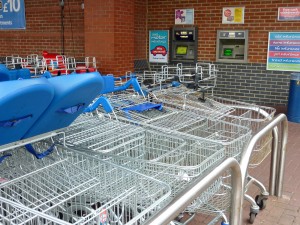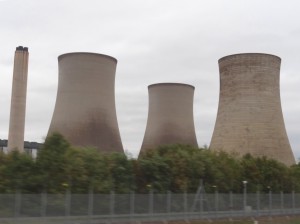 In oligopoly markets, because there are a small number of firms, each firm is affected by its rivals’ decisions. This interdependence results in a tension between cooperation and competition. On the one hand, firms collectively benefit from cooperating and keeping prices high.
In oligopoly markets, because there are a small number of firms, each firm is affected by its rivals’ decisions. This interdependence results in a tension between cooperation and competition. On the one hand, firms collectively benefit from cooperating and keeping prices high.
On the other hand, an individual firm then has an incentive to undercut its rivals to steal a larger share of the market. This incentive to undercut can potentially result in price wars between firms. This is exactly what has recently occurred between pizza sellers on the Avenue of Americas in Midtown New York. Here, until recently the 6th Ave. Pizza company was selling pizza for $1.50 per slice. However, the entry of two competitors nearby sparked an intense and bitter price war.
First, an outlet called Joey Pepperoni’s Pizza opened nearby and charged $1 per slice. This price was then matched by the 6th Avenue Pizza company. Then, the 2 Bros. pizza chain opened an outlet almost next door to the 6th Avenue Pizza company. Initially, they also charged $1 per slice.
 However, this did not last for too long. First 6th Avenue cut its price to 79 cents and then 2 Bros. responded by cutting its price to 75 cents, which 6th Avenue quickly matched.
However, this did not last for too long. First 6th Avenue cut its price to 79 cents and then 2 Bros. responded by cutting its price to 75 cents, which 6th Avenue quickly matched.
Which company started this price war has been subject to some debate. The owners of the 6th Avenue Pizza company were angry, alleging that 2 Bros. was trying to force them out of business. However, the owners of 2 Bros. claimed that they were simply responding to the 6th Avenue Pizza company’s decision to start charging 79 cents per slice and they even have evidence from their security cameras confirming this! When asked why they cut their price the owners of the 6th Avenue company said that:
He was taking away our customers. How were we going to pay our rent?
So what will happen next in this market? One of the owners of the 2 Bros. company has said that they will go back to $1 per slice if the 6th Avenue Pizza company does the same, as they can’t make any profit at the current price. However, the tension between cooperation and competition suggests this may be difficult to sustain.
In the meantime, both are quoted suggesting that they may be tempted to reduce prices even further. 6th Avenue Pizza company stated:
We may go to 50 cents. I want to hit him. I want to beat him.
2 Bros. said:
We might go to free pizza soon.
Of course, while the price war continues, the clear winners are the consumers. In the article one is quoted as saying:
I think it’s beautiful. We need 75-cent hamburgers next.
Articles
Questions
- Why is it difficult for firms to maintain high prices in oligopolistic markets?
- What are the key features of competition in the pizza market?
- Is this the type of market where you would expect price wars to be likely?
- How might firms in this market try to differentiate their product?
- Do you think prices will ever return to $1.50 per slice in this market? Explain.
 After weak Christmas trading, Tesco issued a profit warning – its first in 20 years. Following this, their shares fell in value by some £5bn, but this was met with an announcement of the creation of 20,000 jobs in the coming years, as part of a project to train staff, improve existing stores and open new ones. Yet, Tesco has reported another quarter of falling sales.
After weak Christmas trading, Tesco issued a profit warning – its first in 20 years. Following this, their shares fell in value by some £5bn, but this was met with an announcement of the creation of 20,000 jobs in the coming years, as part of a project to train staff, improve existing stores and open new ones. Yet, Tesco has reported another quarter of falling sales.
Trading times have been challenging and the fact that the UK’s biggest supermarket is struggling is only further evidence to support this. In the 13 weeks to the 26th May 2012, Tesco reported a decline in like-for-like sales of 1.5%. Although much of the £1bn investment in Tesco is yet to be spent, the fact that sales have fallen for a full year must be of concern, not only to its Chief Executive, but also to analysts considering the economic future for the UK.
Consumer confidence remains low and together with tight budgets, shoppers are continuing to be very cautious of any unnecessary spending. Part of Tesco’s recent drive to drum up sales has been better customer service and a continuing promotion war with the other supermarkets. This particular sector is highly competitive and money-off coupons and other such promotions plays a huge part in the competitive process. Whilst low prices are obviously crucial, this is one sector where non-price competition can be just as important.
Although Tesco sales in the UK have been nothing to shout about – the Chief Executive said their sales performance was ‘steady’ – its total global sales did increase by 2.2%. The Chief Executive, Mr Clarke said:
‘Internationally, like-for-like sales growth proved resilient, despite slowing economic growth in China…Against the backdrop of continued uncertainty in the eurozone, it is pleasing to see that our businesses have largely sustained their performance.’
A boost for UK sales did come with the Jubilee weekend and with the Olympics just round the corner, Tesco will be hoping for a stronger end to the year than their beginning. The following articles consider Tesco’s sales and the relative performance of the rest of the sector.
Tesco’s quarterly sales hit by ‘challenging’ trading BBC News (11/6/12)
Tesco UK arm notches up one year of falling sales Guardian, Zoe Wood (11/6/12)
Tesco upbeat despite new sales dip Independent, Peter Cripps (11/6/12)
Tesco sales seen lower in first quarter Reuters, James Davey(11/6/12)
The Week Ahead: Tesco set to admit it is losing ground to rivals Independent, Toby Green (11/6/12)
Tesco’s performance in the UK forecast to slip again Telegraph, Harry Wallop (10/6/12)
Tesco: What the analysts say Retail Week, Alex Lawson (11/6/12)
Supermarkets issue trading updates The Press Association (9/6/12)
The Week Ahead: Supermarkets prepare to give City food for thought Scotsman, Martin Flanagan (11/6/12)
Asda’s sales growth accelerates Reuters, James Davey (17/5/12)
Asda sales increase helped by Tesco Telegraph, Harry Wallop (18/5/12)
Tesco v. Sainsbury’s in trading update battle Manchester Evening News (11/6/12)
Sainsbury’s out-trades Tesco on UK food sales Independent, James Thompson (10/6/12)
Questions
- Using some examples, explain what is meant by non-price competition.
- Why has Tesco been losing ground to its competitors?
- Given the products that Tesco sells (largely necessities), why have sales been falling, despite household’s tight budgets?
- Into which market structure would you place the supermarket sector? Explain your answer by considering each of the assumptions behind the market structure you choose.
- Why have Tesco’s rivals been gaining ground on Tesco?
- How might this latest sales data affect Tesco’s share prices?
- Based on what the analysts are saying about the food sector, can we deduce anything about the future of the UK economy in the coming months?
 The Office for Budget Responsibility has said that the UK Treasury will face a shortfall of £13bn in motoring taxes within a decade. Although car usage continues to rise putting increasing pressure on the road infrastructure, the greener and more fuel efficient cars being produced are driving down the tax revenues generated from motoring.
The Office for Budget Responsibility has said that the UK Treasury will face a shortfall of £13bn in motoring taxes within a decade. Although car usage continues to rise putting increasing pressure on the road infrastructure, the greener and more fuel efficient cars being produced are driving down the tax revenues generated from motoring.
A report by the IFS has put forward the case for replacing the existing system of taxes on cars and fuel by a new road charging system. If no such change occurs, the IFS has forecast that with more electric cars and hence lower revenues raised from fuel and vehicle excise duties, the shortfall facing the Treasury would require an increase in fuel duty of some 50%. Instead of this, the solution could be to charge individuals for every mile of road they use, with the ‘price’ varying depending on the degree of congestion. For example, at peak times the price would be higher, where as for those in the countryside where roads are traditionally much quieter, charges would be lower. The IFS said:
 ‘Such a move would generate substantial economic efficiency gains from reduced congestion, reduce the tax levied on the majority of miles driven, leave many (particularly rural) motorists better off, and provide a stable long-term footing for motoring taxes without necessarily raising net additional revenue from drivers.’
‘Such a move would generate substantial economic efficiency gains from reduced congestion, reduce the tax levied on the majority of miles driven, leave many (particularly rural) motorists better off, and provide a stable long-term footing for motoring taxes without necessarily raising net additional revenue from drivers.’
Government policy across the world has been increasingly focused on climate change, with targets for emissions reductions being somewhat ambitious. However, many car manufactures who were told to reduce emissions significantly are on the way to meeting these targets and this success is a key factor contributing towards this new road ‘crisis’ that could soon be facing the government. The following articles consider the possibility of a road charging scheme.
Report
The road ahead for motoring taxes? Institute of Fiscal Studies (link to full report at the bottom of the page) (May 2012)
Articles
Compelling case for UK road charging, IFS study says BBC News (15/5/12)
Fears tax shortfall may lead to road tolls Sky News (15/5/12)
Who’s going to pay to update Britain’s infrastructure? Guardian Business Blog (15/5/12)
Motoring taxes: a future headache for the Chancellor Channel 4 News (15/5/12)
For whom the toll bills – less traffic hurts M6 toll road owner Guardian, Ian Griffiths and Dan Milmo (14/5/12)
Charge motorists per mile, says IFS Independent, Nigel Morris (15/5/12)
Green cars to drive down tax receipts Financial Times, Mark Odell and John Reed (15/5/12)
Questions
- Illustrate the effect of a tax being imposed on petrol. What happens to the equilibrium price and quantity?
- Despite fuel duty pushing up the price of petrol, why has there been such a small decline in the quantity of petrol individuals use?
- Evaluate the case for and against a road charging scheme.
- Why are tax revenues from motoring expected to decline over the next decade?
- Climate change has become an increasingly important focus of government policy. To what extent is the current road ‘crisis’ a positive sign that policies to tackle climate change are working?
- If a road charging scheme went ahead and prices were varied depending on traffic, time etc, what name would you give to this strategy?
- Why would it be possible to charge a higher price at peak times and a lower price for cars using country roads?
- Is there an argument for privatising the road network? Is it even possible?
 Centrica, owners of British Gas, has warned that electricity and gas prices in the UK are set to rise in the autumn. Centrica blames this on the expected rise in the costs of wholesale gas and other non-energy inputs.
Centrica, owners of British Gas, has warned that electricity and gas prices in the UK are set to rise in the autumn. Centrica blames this on the expected rise in the costs of wholesale gas and other non-energy inputs.
One of the other ‘big six’ energy suppliers, E.On, has responded by saying that it will not raise energy prices this year. Whether it will raise prices after 1 Jan next year remains to be seen.
Last autumn, household energy prices rose substantially: between 15.4% and 18% for gas and between 4.5% and 16% for electricity. This spring, in response to lower wholesale energy prices, suppliers cut prices for either electricity or gas (but not both) by around 5%.
The government and various pressure groups are encouraging consumers to use price comparison sites to switch to a cheaper supplier. The problem with this is that supplier A may be cheaper than supplier B one month, but B cheaper than A the next. Nevertheless, switching does impose some degree of additional competitive pressure on suppliers.
More powerful pressure could be applied by ‘collective switching’. This is where a lot of people switch via an intermediary company, which sources a deal from an energy supplier. This collective buying is a form of countervailing power to offset the oligopoly power of the suppliers. Such schemes are being encouraged by the Energy Minister, Ed Davey.
The other approach, apart from doing nothing, is for Ofgem, the energy regulator, to impose tough conditions on pricing. But at present, Ofgem’s approach has been to try to make the market more competitive (see also), rather than regulating prices.
British Gas owner Centrica warns of higher energy bills BBC News (11/5/12)
E.ON to keep residential energy prices unchanged in 2012 Reuters, Adveith Nair (14/5/12)
E.ON promises to hold energy prices for 5million customers in 2012 This is Money, Tara Evans (14/5/12)
British Gas owner Centrica feels cold blast from critics ShareCast, John Harrington (11/5/12)
Gas and electricity price battle lines drawn BBC News (14/5/12)
Taking on the energy giants: The co-operative insurgency gains ground Left Foot Forward, Daniel Elton (11/5/12)
Group Energy Buying hits the UK Headlines Spend Matters UK/Europe, Peter Smith (11/5/12)
Think tank calls for competition to break Big Six rip-off Energy Live News, Tom Gibson (30/4/12)
Collective switching will not fix the UK’s broken energy market Guardian, Reg Platt (27/4/12)
Make your own small switch for cheaper energy The Telegraph, Rosie Murray-West (14/5/12)
Questions
- What are the barriers to entry in the electricity supply market?
- How competitive is the retail energy market at present?
- To what extent do price comparison sites put pressure on energy companies to reeduce prices or limit price increases?
- What scope is there for collective buying of gas and electricity from the six energy suppliers by (a) households; (b) firms?
- Assess Ofgem’s package of proposals for a simpler and more competitive energy market.
 Cartels are formal collusive agreements between firms, typically to fix prices, restrict output or divide up markets. As in the case of monopoly, the lack of competition may harm consumers, who are likely to have to pay higher prices. This, as economic theory demonstrates, results in a reduction in overall welfare.
Cartels are formal collusive agreements between firms, typically to fix prices, restrict output or divide up markets. As in the case of monopoly, the lack of competition may harm consumers, who are likely to have to pay higher prices. This, as economic theory demonstrates, results in a reduction in overall welfare.
For this reason competition authorities throughout the world now impose substantial fines on firms found to be involved in collusive activities and participants also face the threat of substantial jail sentences.
One of the most famous cartels is the Organization of Petroleum Exporting Countries (OPEC). This is an agreement between 12 countries to limit their production of oil. The OPEC cartel has been in place for over 50 years. Arguably, the intergovernmental nature of the cartel and political ramifications of intervening have meant that OPEC has been able to operate free from prosecution for so long.
However, very interestingly Freedom Watch, a US public interest group founded by a former US Department of Justice lawyer, has this week filed a lawsuit against OPEC for violation of competition laws. Quoted in the above press release, Larry Klayman, the founder of Freedom Watch, says that:
These artificially-inflated crude oil prices fall hard on the backs of Americans, many of whom cannot afford to buy gasoline during these severely depressed economic times.
Furthermore, how some of the members use the profits gained from the cartel is also called into question. He also goes on to suggest that the lack of intervention from US government agencies may be because the leaders of both political parties:
… line their pockets from big oil interests and are just sitting back and not doing anything.
This is not the first time that Freedom Watch has served a lawsuit on OPEC. In 2008, at an OPEC meeting in Florida:
In a bold move in front of members of the news media, Freedom Watch Chairman and Chief Legal Counsel Larry Klayman literally jumped out from behind a line of TV cameras and microphones on Friday, October 24, to serve a complaint on an OPEC oil minister.
That complaint was unsuccessful.
It will be fascinating to see the outcome of this latest case and, if successful, the implications for OPEC – updates to appear on this blog in due course.
Articles
Profile: Opec, club of oil producing states BBC News (01/02/12)
OPEC accused of conspiracy against consumers WND World, Bob Unruh (09/05/12)
Freedom Watch Attorney Sues OPEC Oil Minister for Economic Terrorism Conservative Crusader, Jim Kouri (31/10/08)
Lawsuits
Lawsuit brought by Freedom Watch inc. against OPEC (7/5/12)
Lawsuit brought by Freedom Watch inc. against OPEC (9/6/08)
Questions
- Why are cartels so severely punished?
- Why might it be important to punish the individuals involved as well as fine the cartel members?
- Why is fixing the price of oil particularly harmful for the economy?
- Why do you think the OPEC cartel has survived for so long?
- What do you think might be the long term implications of the lawsuit for OPEC?
 In oligopoly markets, because there are a small number of firms, each firm is affected by its rivals’ decisions. This interdependence results in a tension between cooperation and competition. On the one hand, firms collectively benefit from cooperating and keeping prices high.
In oligopoly markets, because there are a small number of firms, each firm is affected by its rivals’ decisions. This interdependence results in a tension between cooperation and competition. On the one hand, firms collectively benefit from cooperating and keeping prices high. However, this did not last for too long. First 6th Avenue cut its price to 79 cents and then 2 Bros. responded by cutting its price to 75 cents, which 6th Avenue quickly matched.
However, this did not last for too long. First 6th Avenue cut its price to 79 cents and then 2 Bros. responded by cutting its price to 75 cents, which 6th Avenue quickly matched.



